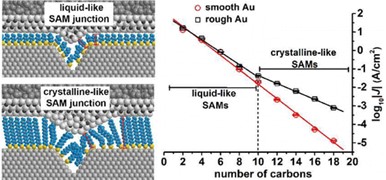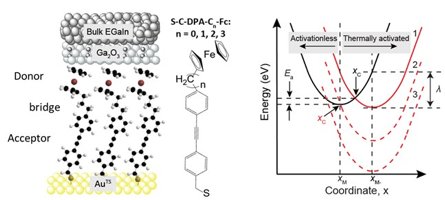Molecular junctions are excellent testbeds to study the most fundamental aspects of the mechanisms of charge transport across molecules and molecule—electrode interfaces. We are especially interested in charge transport regimes where charge carriers interact strongly with the molecule leading to interesting secondary effects (such as switching). Generally speaking, charges can tunnel coherently or incoherently (also called hopping) across molecules. The former mechanism can be described well by the Landauer formalism and the latter by the Marcus theory. In reality, the mechanism of charge transport depends on a large number of intertwined factors (the chemical and electrical structure of the molecules, molecule—electrode interactions, defects, molecule—molecule interactions, just to name a few) leading to new phenomena that cannot readily be explained by either theory.  We are especially interested in the role of the dynamical properties of the molecules and that affect the structure of the junctions and the mechanism of charge transport. For instance, we found that thin liquid-like monolayers form better barriers against tunnelling than thick solid like monolayers because of their dynamical behaviour they are capable of self-repair. This self-repair readily irons out defects resulting in high quality tunnelling barriers even for defective junctions with rough Au electrodes (Nano Lett. 2015, 15, 6643-6649).
We are especially interested in the role of the dynamical properties of the molecules and that affect the structure of the junctions and the mechanism of charge transport. For instance, we found that thin liquid-like monolayers form better barriers against tunnelling than thick solid like monolayers because of their dynamical behaviour they are capable of self-repair. This self-repair readily irons out defects resulting in high quality tunnelling barriers even for defective junctions with rough Au electrodes (Nano Lett. 2015, 15, 6643-6649).
One of the peculiar predictions of the Marcus theory was the Marcus Inverted region (where reaction rates slow down due to an increase of the activation energy, despite an increase of the Gibbs free energy) which took about 30 years to experimentally confirm. In solution, the electron transfer rate is much larger than the diffusion rate of the reactants which hampered accessing the Marcus Inverted region. By fixing the electron donor and acceptor units within the same molecule (donor—bridge—acceptor (D-b-A) compounds), the Inverted Marcus region could be finally accessed. We found that the Marcus Inverted region can also be accessed in molecular tunnel junctions where the molecules are connected to the electrodes and, thus, are not diffusion limited (Nat. Nanotechnol. 2018, 13, 322-329). Here, charges hop from the donor to the acceptor but charging of the donor results in intramolecular orbital gating which lowers the energy of the acceptor. This coupling can be controlled by changing the number of -CH2- units and is the strongest for n=0 pushing the junction in the Marcus Inverted region (Situation 3 as sketched with Marcus parabolas). Interestingly, molecular junction operating the inverted Marcus region results in temperature independent charge transport because the activation energy is compensated by the energy from the leads which can be used to improve the performance of molecular devices (Adv. Sci. 2021 accepted).

